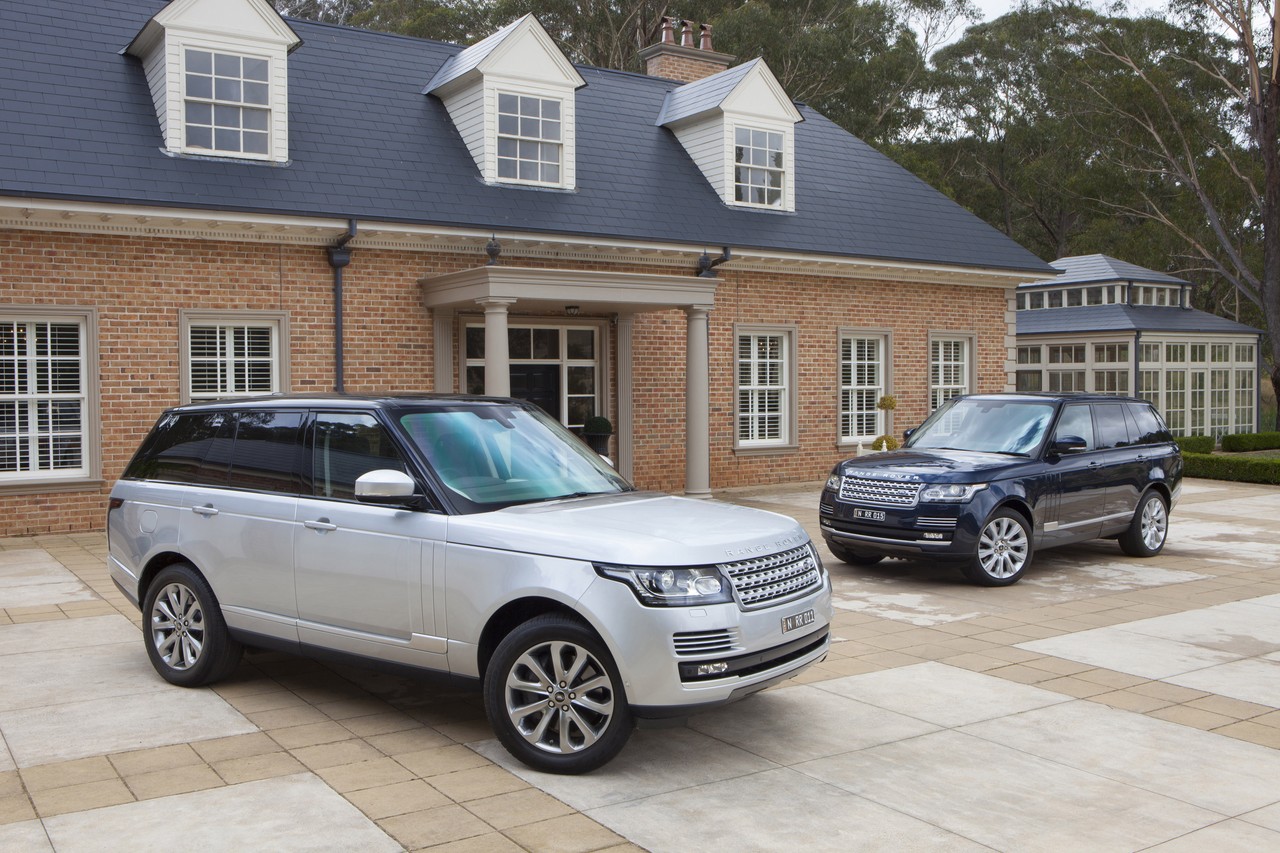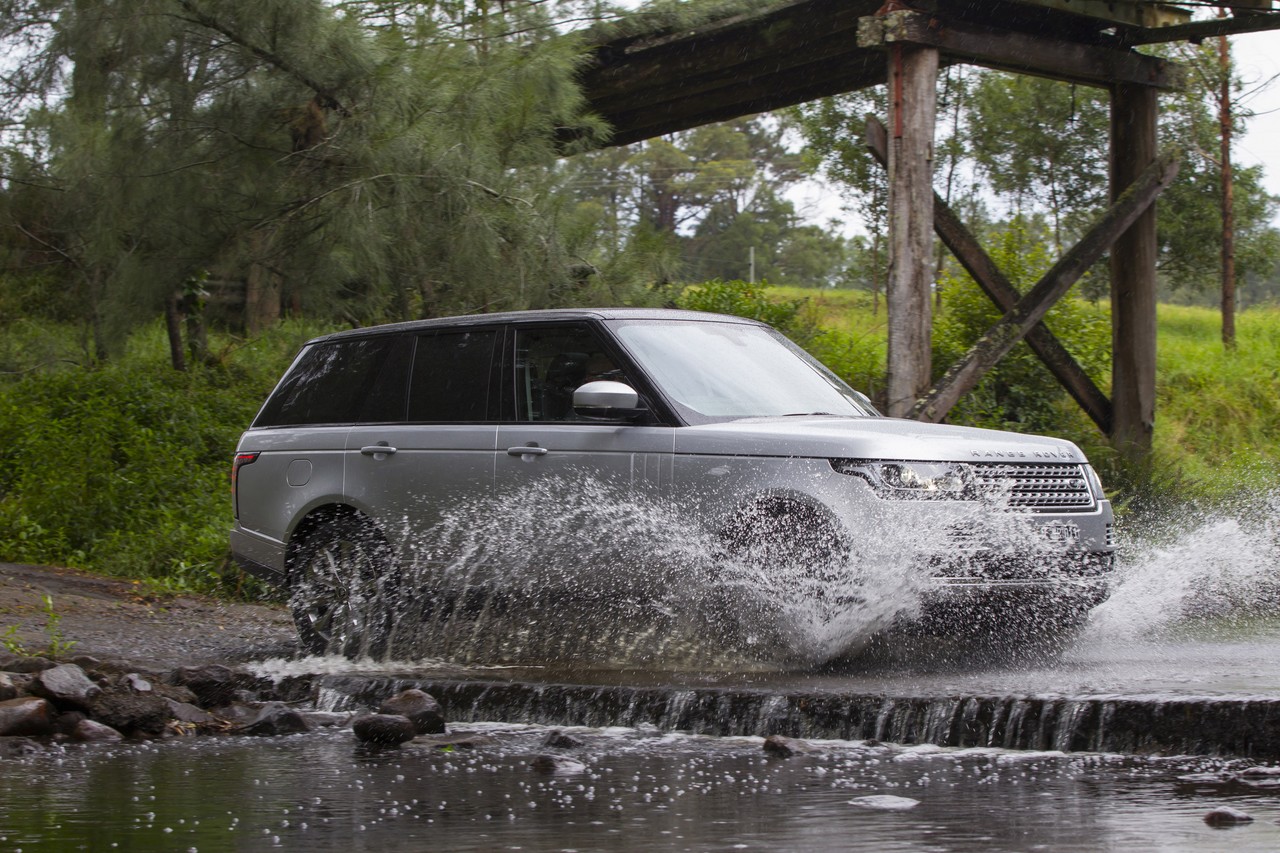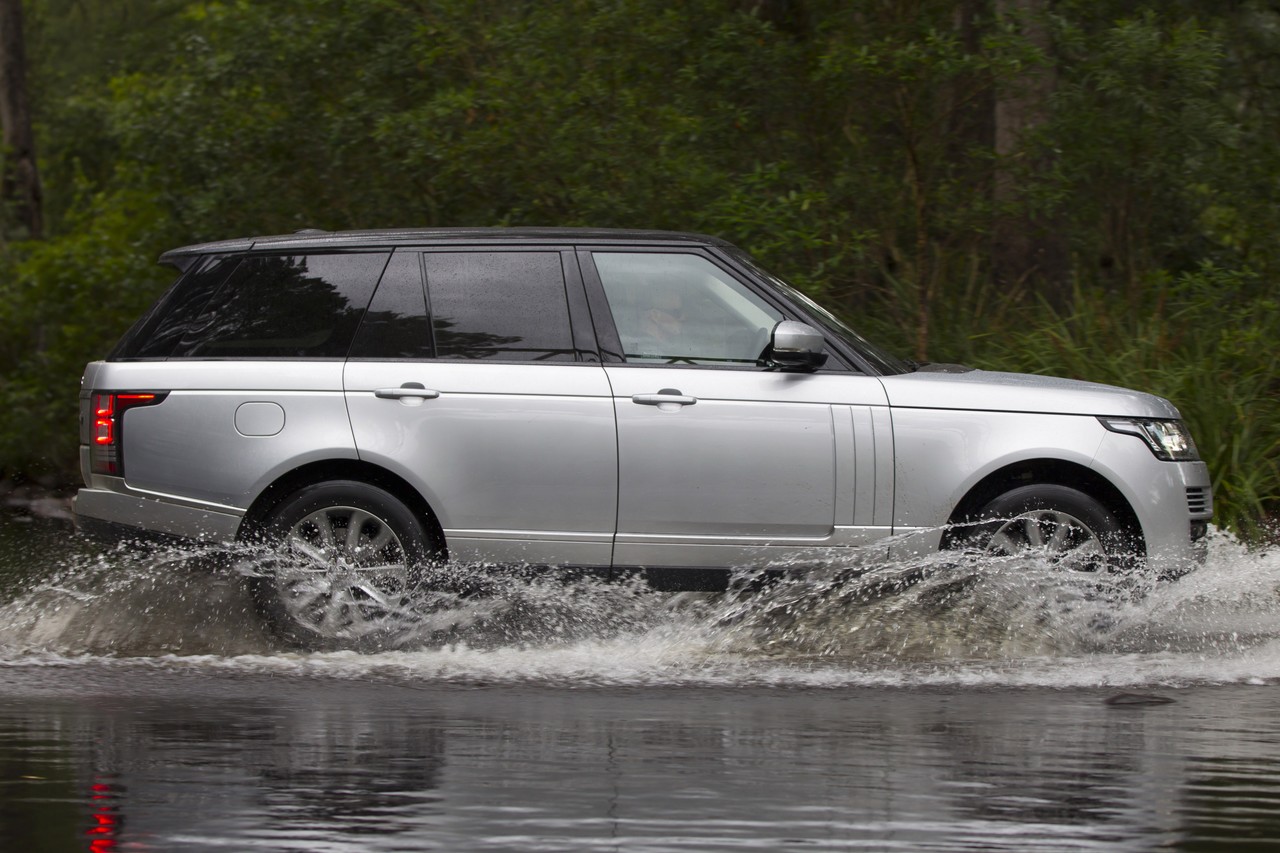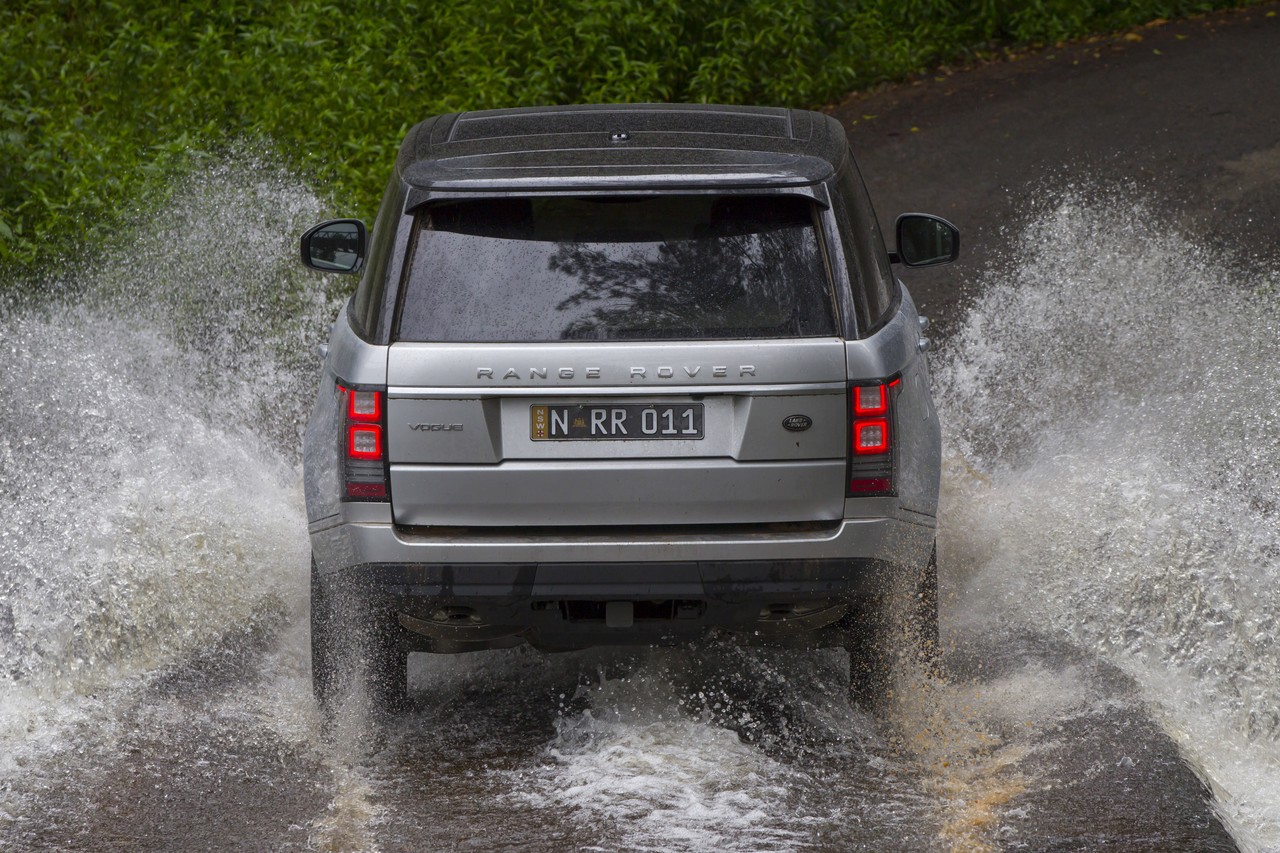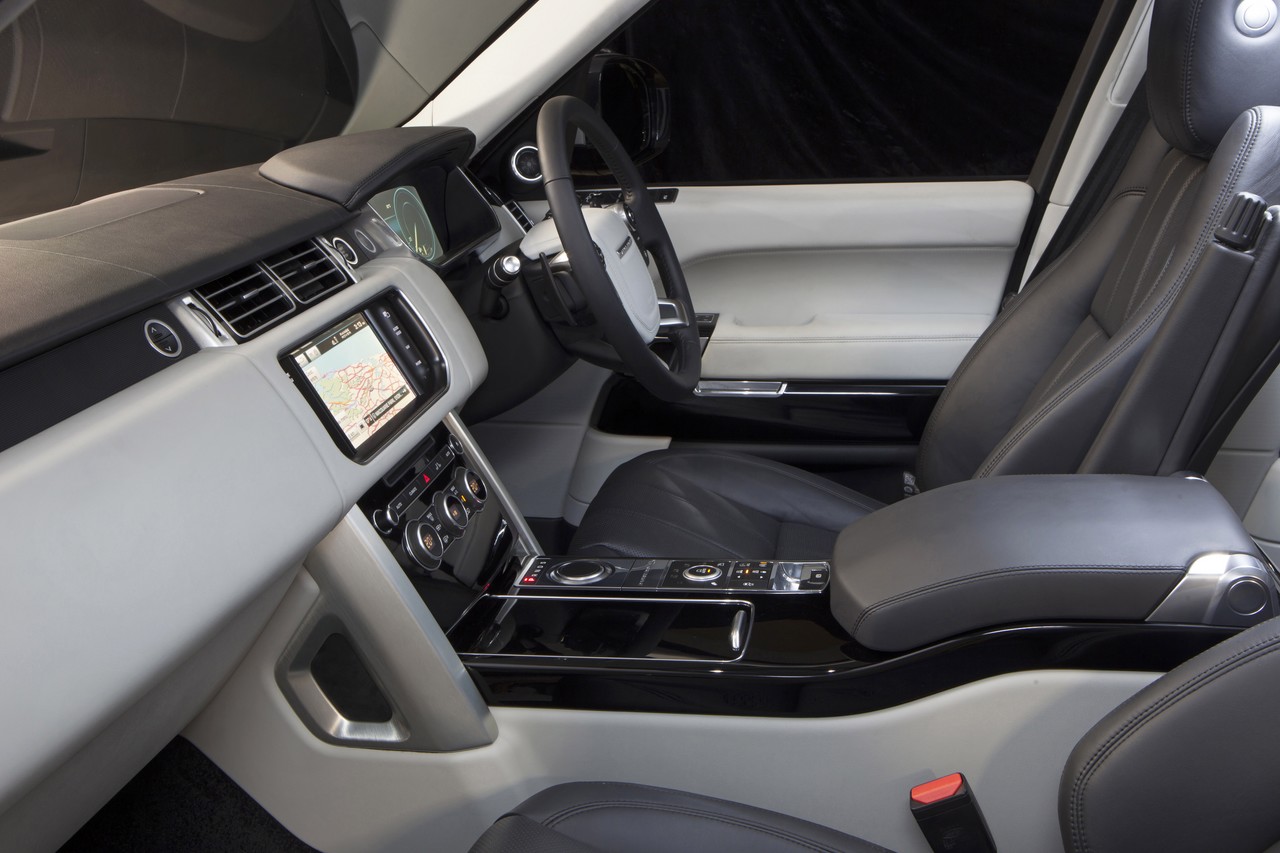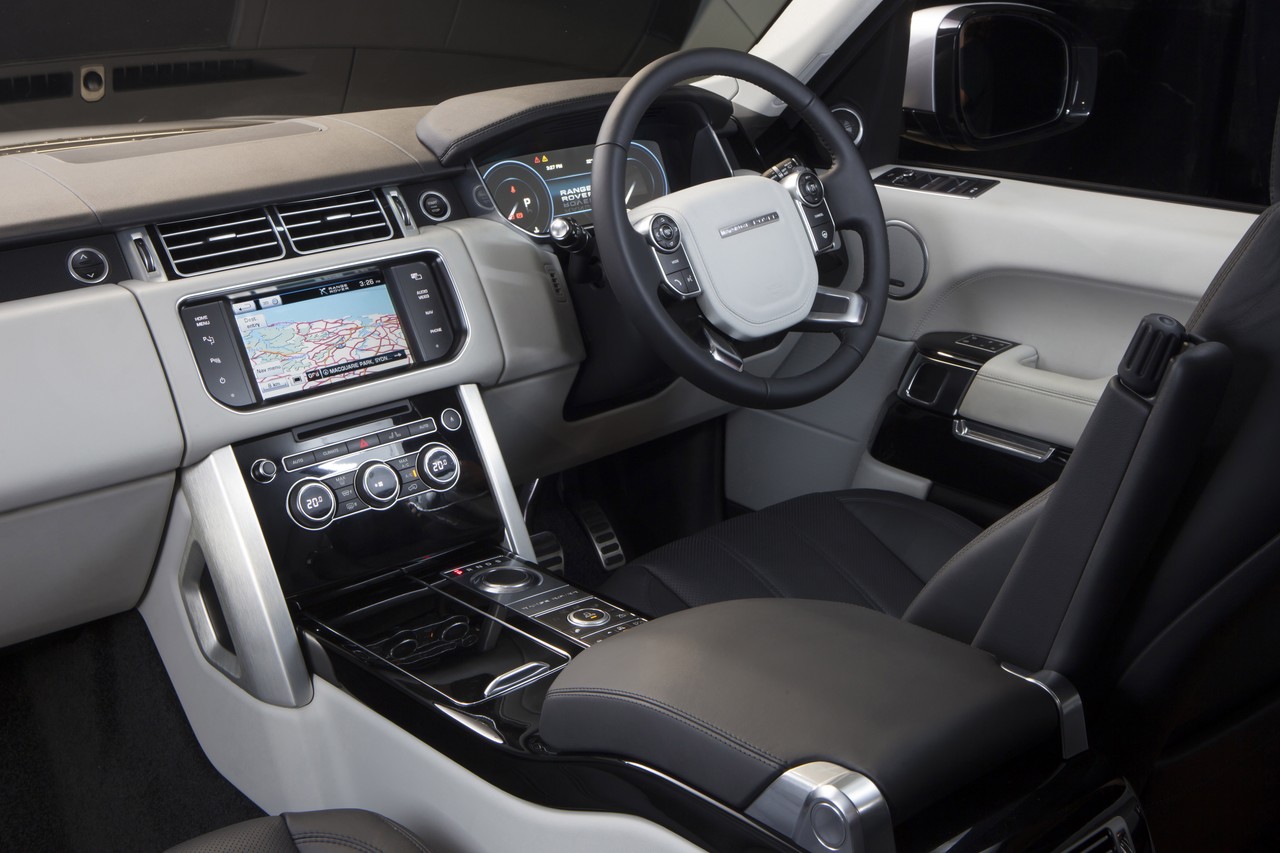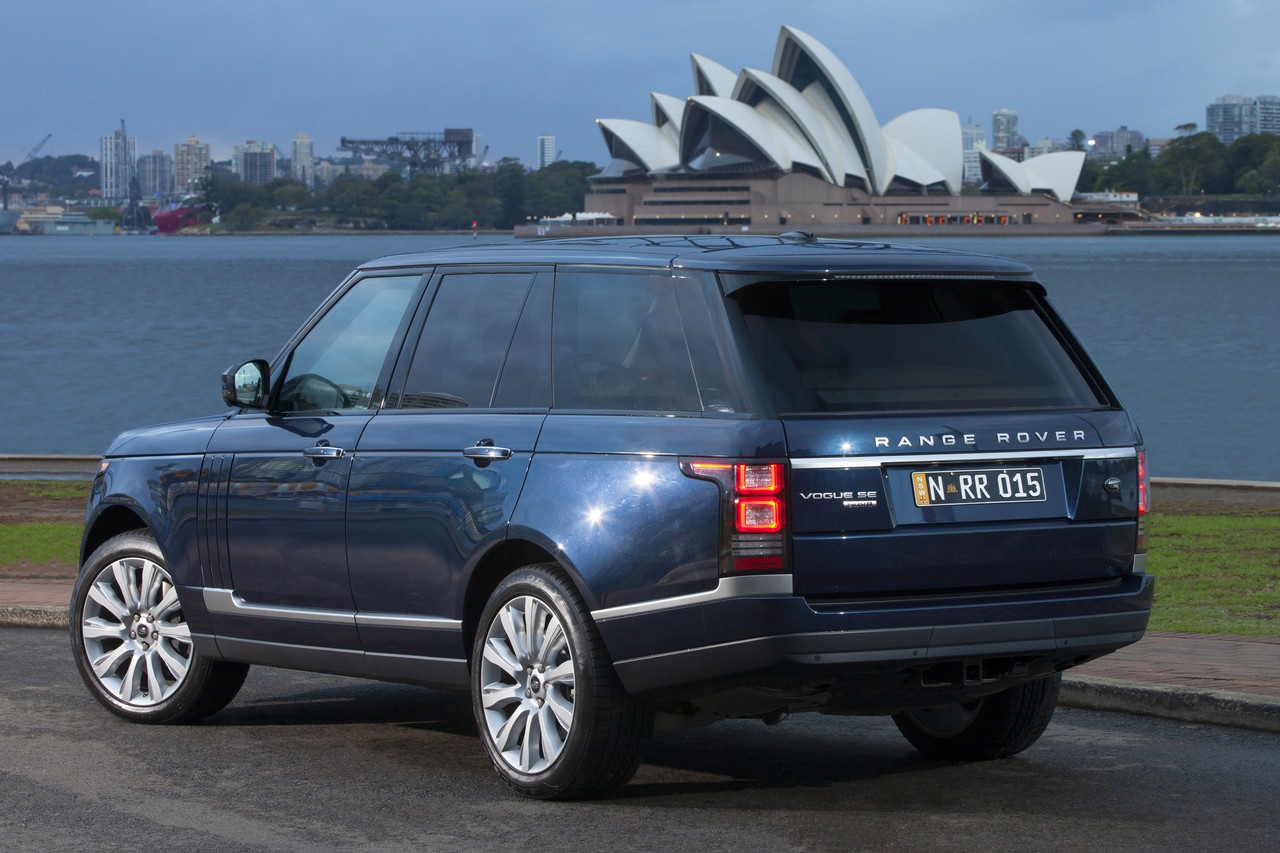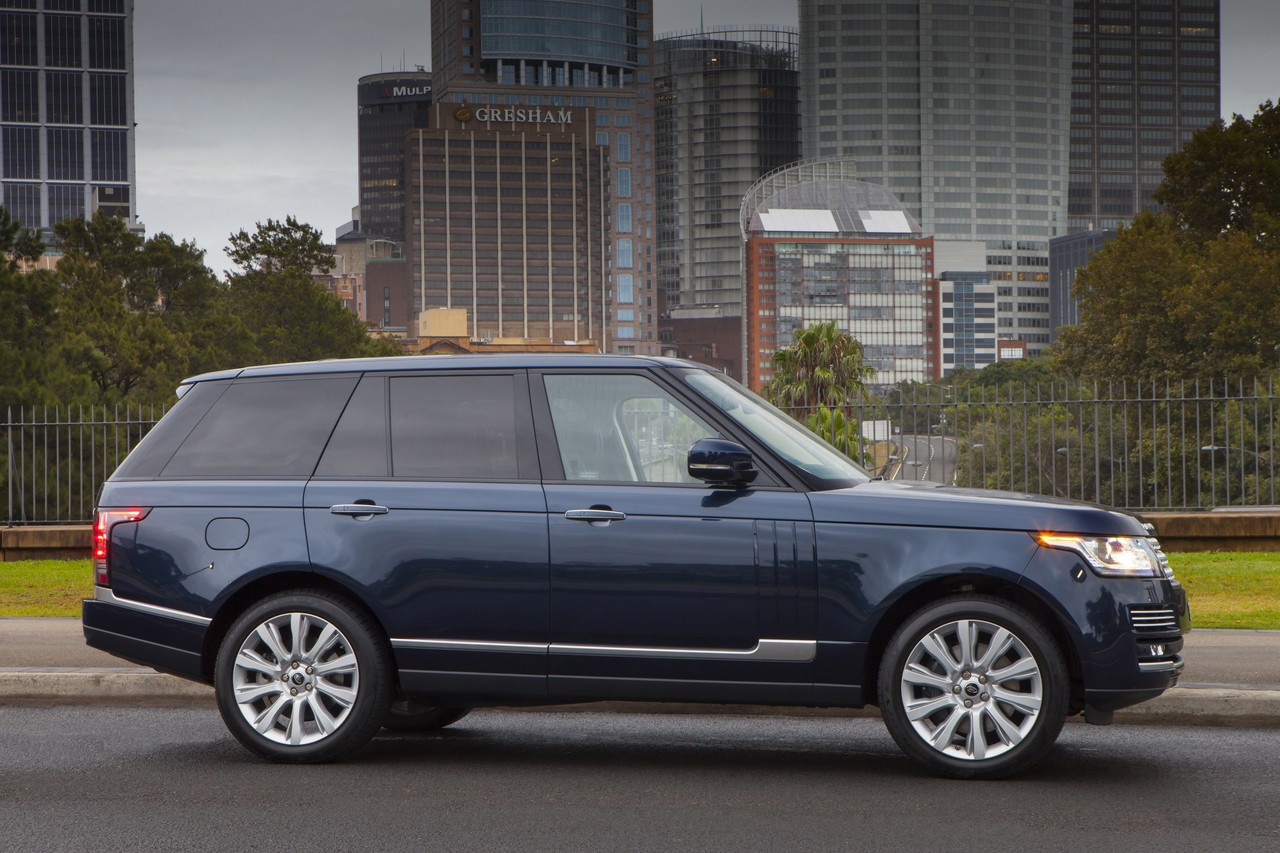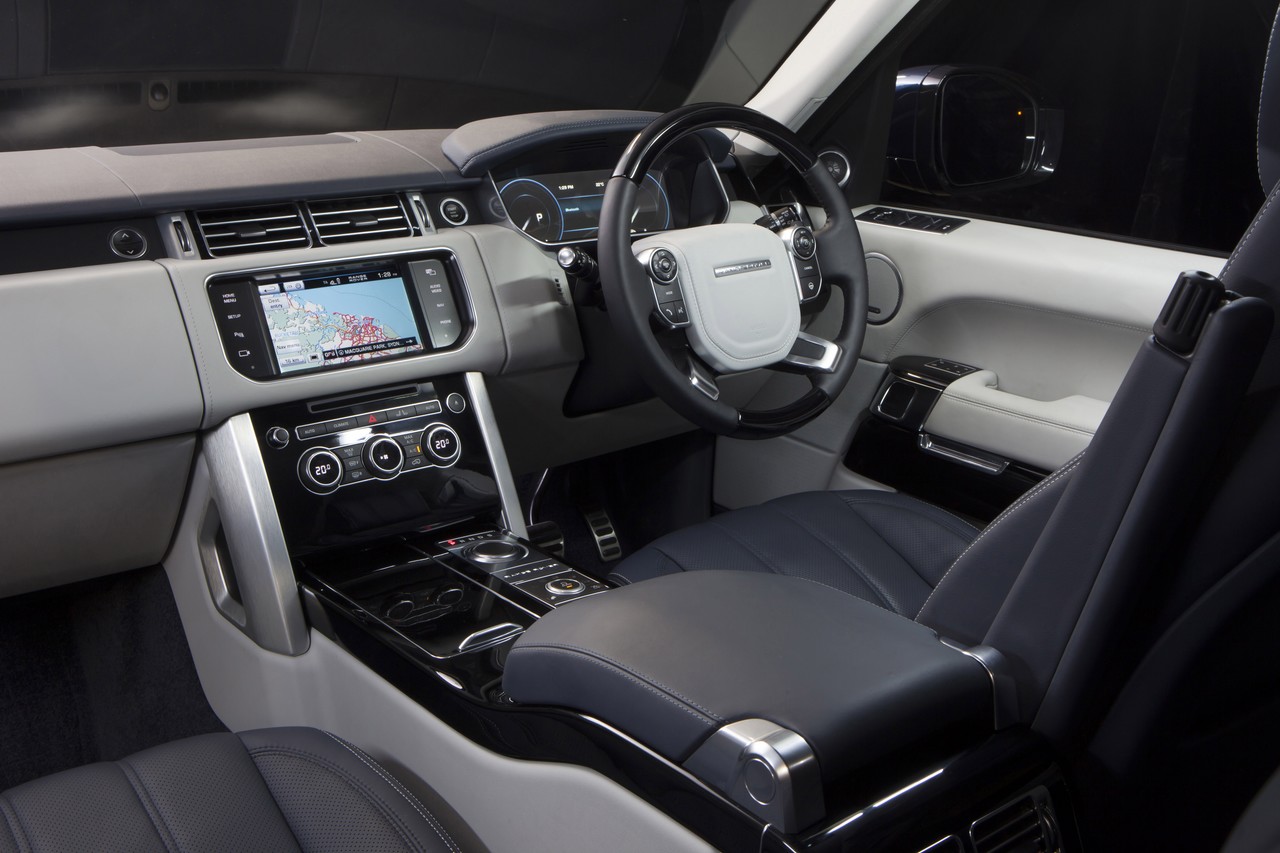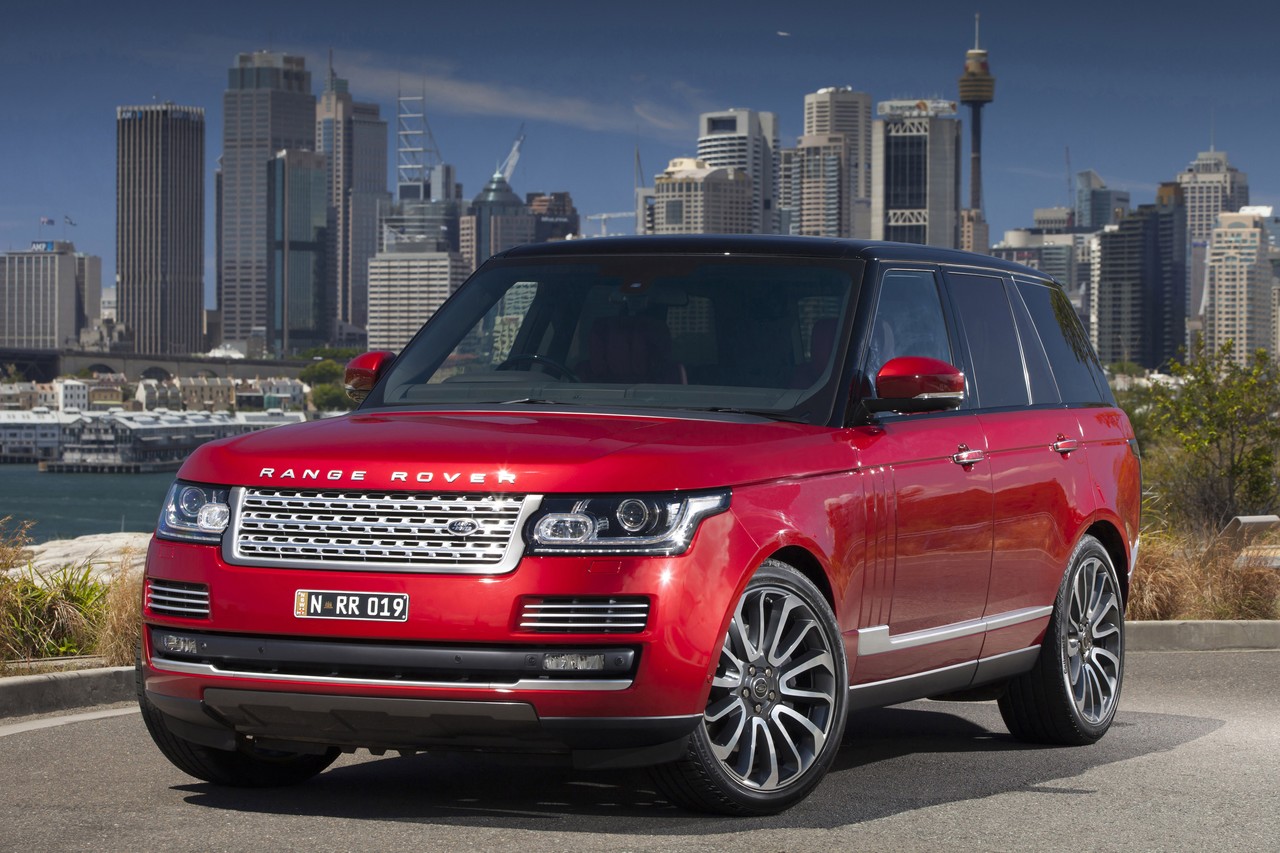
- Responsive 3.0-litre turbo-diesel V6 engines
- Supportive front seats
- Supreme ride comfort
- Off-road capability
- Quiet, well-insulated cabin
- Steering provides excellent feel
- Fuel consumption of petrol engines
- Weight blunts agility
- Limited boot space
- High retail prices and potential depreciation
Overview
Released in February 2013, the Land Rover L405 Range Rover was a large, four-wheel drive wagon. Manufactured in Solihull, UK, the L405 Range Rover was initially available in TDV6, SDV8 and V8 Supercharged variants; in July 2013, the range was expanded with V6 Supercharged variants; the full range is given in the table below.
Engines
For TDV6 and SDV8 variants, the 3.0- and 4.4-litre diesel engines had compacted graphite iron blocks, cross-bolted main bearing caps, common-rail injection, double overhead camshafts, four valves per cylinder, diesel particulate filters and compression ratios of 16.0:1. Where the engines differed, however, is that the TDV6 had a single turbocharger and a stop/start system which enabled it to shut down when the vehicle was stationary in traffic. In contrast, the SDV8 engine had twin-turbochargers.
For the V6 Supercharged and V8 Supercharged variants, the 3.0- and 5.0-litre engines had die-cast aluminium blocks, cross-bolted main bearing caps, direct fuel injection, double overhead camshafts, dual independent variable cam timing (DIVCT), four valves per cylinder, a twin vortex supercharger (positioned in the engine’s ‘V’) and a water-cooled intercooler. While the V6 Supercharged engine had a compression ratio of 10.5:1, the V8 Supercharged engine had a compression ratio of 9.5:1.
Released in August 2014, the Range Rover Hybrid combined Land Rover’s SDV6 engine with a hybrid system – consisting of a lithium-ion battery pack, an inverter and a 35 kW electric motor – which weighed less than 120 kg. The electric motor could also act as a generator and harvest kinetic energy when the vehicle was braking (regenerative braking) to recharge the battery. In electric vehicle (‘EV’) mode, the Range Rover Hybrid could travel at speeds of up to 48 km/h for a range of 1.6 kilometres.
| Variant | Editions | W/b | Engine | Trans. | Years | Peak torque | |
|---|---|---|---|---|---|---|---|
| TDV6 | HSE | SWB | 3.0-litre turbo-diesel V6 | 8sp auto | 2013-18 | 190 kW at 4000 rpm | 600 Nm at 2000 rpm |
| Vogue | SWB, LWB |
||||||
| SDV6 | HSE | SWB | 3.0-litre turbo-diesel V6 | 8sp auto | 2018-21 | 202 kW | 625 Nm |
| Vogue | SWB, LWB |
||||||
| SDV8 | Vogue, Vogue SE, Autobi-ography |
SWB, LWB |
4.4-litre twin-turbo diesel V8 | 8sp auto | 2013-14 | 250 kW at 3500 rpm | 700 Nm at 1750-3000 rpm |
| 2014-21 | 250 kW at 3500 rpm | 740 Nm at 1750-2000 rpm | |||||
| V6 Super-charged | HSE, Vogue |
SWB | 3.0-litre super-charged petrol V6 | 8sp auto | 2013-21 | 250 kW at 6500 rpm | 450 Nm at 3500-5500 rpm |
| V8 Super-charged | Vogue SE, Autobi-ography |
SWB, LWB |
5.0-litre super-charged petrol V8 | 8sp auto | 2013-21 | 375 kW at 6000-6500 rpm | 625 Nm at 2500-5500 rpm |
| Hybrid | Vogue SE | LWB | 3.0-litre turbo-diesel V6 | 8sp auto | 2014-17 | 215 kW at 4000 rpm | 600 Nm at 2000 rpm |
| Electric motor | 35 kW | 170 Nm | |||||
| Combined | 250 kW | 700 Nm at 1500-3000 rpm | |||||
4WD system
The permanent four-wheel drive system had a bevel centre gear differential which provided a default 50:50 front/rear torque split. However, an electronically-controlled, multi-plate clutch provided a centre differential lock and torque biasing function to vary torque distribution as required.
The two-speed transfer box had a high range 1:1 direct drive ratio and a 2.93:1 low-range. To further optimise traction and stability in extreme conditions, customers were also able to specify an Active Rear Locking Differential on 4.4 SDV8 and 5.0 V8 Supercharged variants.
Terrain Response 2
The L405 Range Rover was fitted with Land Rover’s Terrain Response 2 system. In its ‘Auto’ setting, the system assessed driving conditions and automatically selected the most suitable vehicle settings from General, Grass/Gravel/Snow, Mud/Ruts, Sand and Rock Crawl; the system could also advise the driver when to engage low range gearing or vary the off-road ride height. Furthermore, Terrain Response 2 included the following all-terrain technologies: Hill Descent Control (HDC), Gradient Release Control (GRC), Hill Start Assist (HSA), Dynamic Stability Control (DSC), Electronic Traction Control (ETC), and Roll Stability Control (RSC).
ZF 8HP70 transmission
All engines were mated to eight-speed ZF 8HP70 automatic transmissions which could be controlled via steering wheel gearshift paddles that enabled sequential gear shifts with shift times of 200 milliseconds. Furthermore, the transmissions were designed to lock the torque converter as early as possible to reduce slip and energy loss, while a ‘Transmission Idle Control’ function disengaged 70 per cent of the drive when the vehicle was idling in Drive to minimise fuel consumption.
Comparison with L322
Compared to its L322 Range Rover Vogue predecessor, the L405 Range Rover Vogue had an all-aluminium monocoque body structure which was 39 per cent lighter than the steel body of its predecessor for a 180 kg mass reduction, while additional measures throughout the chassis and driveline resulted in variant-for-variant savings of around 350 kg. Compared to the L322 Range Rover, the standard L405 Range Rover was 49 mm longer (at 4999 mm), 28 mm lower (1835 mm) and had a 42 mm longer wheelbase (2922 mm). The L405 Range Rover, however, was also available with a long wheelbase (LWB) body which had a 185 mm longer wheelbase (3107 mm) and was 5184 mm long.
Suspension
The L405 Range Rover had fully independent suspension with wide-spaced double-wishbones at the front and an advanced multi-link layout at the rear; the system provided wheel travel of 260 mm at the front and 310 mm at the rear. The four-corner air suspension system was also revised with low-hysteresis front air springs to more effectively absorb road surface irregularities. The air suspension system was cross-linked for maximum axle articulation and – when the off-road setting was selected – could automatically select between two ride heights (+40 mm, +75 mm). The air suspension system also included:
- Adaptive Dynamics with continuously variable damping: fitted as standard, Adaptive Dynamics monitored vehicle movements over 500 times a second and adjusted the variable dampers accordingly; and,
- Dynamic Response active lean control: fitted to the 4.4 SDV8 and 5.0 V8 Supercharged variants, Dynamic Response was a two-channel system which could control the front and rear axles independently. As such, the system could be tuned for low-speed agility or enhanced control and stability at speed.
Safety equipment
Standard safety equipment included dual front airbags, dual front knee airbags, front side airbags, curtain airbags for front and rear occupants, ABS, brake assist, electronic brake force distribution, electronic stability control, cornering brake control, rollover stability control, traction control and front and outer rear seatbelts with pretensioners and load limiters.
Vogue SE variants were further equipped with a Surround Camera System which included a ‘T Junction’ view function, reverse park guidance and Trailer hitch guidance. Beyond this, the Autobiography variants were also fitted with:
- Adaptive Cruise Control with a Queue Assist function which allowed the adaptive cruise control to continue functioning at low speeds and down to a complete stop; and,
- Intelligent Emergency Braking (including Advanced Emergency Brake Assist) which assisted drivers to avoid collisions if the traffic ahead slowed quickly or another vehicle suddenly moved into their lane.
Optional safety equipment for the L405 Range Rover consisted of:
- Blind Spot Monitoring with a Closing Vehicle Sensing function to detect vehicles which were rapidly approaching from a further distance behind; and,
- Reverse Traffic Detection which warned drivers of potential collisions during reversing manoeuvres.
Brakes
The TDV6 and Supercharged V6 variants had 350 mm ventilated disc brakes front and rear. The 4.4 SDV8 and Supercharged V8 variants, however, had 380 mm front brake discs with six-piston Brembo calipers and 365 mm ventilated rear discs.
Euro NCAP testing
In Euro NCAP testing , the L405 Range Rover 3.0 TDV6 received a five star safety rating which included a 91 per cent adult occupant protection rating and an 84 per cent child occupant protection rating. In the front offset crash test, protection for the front occupants was generally rated as good, though chest protection was only rated as adequate for the driver. Maximum points were awarded in the side impact test, though in the more severe pole test, chest protection was rated as marginal.
Under ANCAP’s assessment scheme, the L405 Range Rover received a five star adult occupant protection rating with a score of 36.19 out of 37.
Features: SWB models
Standard features for the Range Rover HSE included 19-inch alloy wheels, a 380 watt Meridian sound system with Bluetooth audio streaming and USB input, a satellite navigation system (HDD) with an eight-inch touchscreen, voice recognition, three-zone climate control air conditioning, grained leather upholstery, eight-way power adjustable front seats, heated front seats, cruise control, front and rear fog lights, xenon headlights with daytime LED running lights, automatic headlights, front parking sensors with visual display, a reversing camera, a leather-wrapped steering wheel, Bluetooth mobile phone connectivity, keyless entry and remote central locking, power windows, power heated and folding mirrors, automatically dipping mirrors for reversing, driver memory settings (seat and mirrors), front and rear carpet mats, tyre pressure monitoring, soft-close doors, three 12 volt power outlets, an alarm and immobiliser.
The Range Rover Vogue was further equipped with 20-inch alloy wheels, digital TV receiver, Oxford leather upholstery, twelve-way power adjustable front seats, heated rear seats, a heated steering wheel and auto-dimming exterior mirrors.
Beyond this, the Range Rover Vogue SE added 21-inch alloy wheels, an 825 watt Meridian surround sound system, semi-aniline leather upholstery, 18-way power adjustable front seats with adjustable bolsters, ventilated front and rear seats, power adjustable rear seats, front and rear winged headrests, a surround view camera system, a rear seat entertai Nment system (with a Dual View touch screen, remote control and wireless headphones) high beam assist, sliding panoramic roof (with power blind), passenger memory settings and rear privacy glass.
The range-topping Range Rover Autobiography was distinguished by its 22-inch alloy wheels, four-zone climate control air conditioning, front seat massage function and leather headlining.
Features: LWB models
Compared to their standard wheelbase counterparts, the long wheelbase (LWB) Range Rover was further equipped with a sliding panoramic roof which included power blinds, configurable interior mood lighting, illuminated aluminium tread plates and powered rear window blinds. Visually, the LWB models could be identified by their ‘Santorini Black’ door mirror caps.
Beyond this, the LWB Vogue SE added a solar attenuating glass windscreen, laminated hydrophobic front door glass and rear privacy glass. Finally, the LWB Autobiography editions were distinguished by their 21-inch ten-spoke diamond turned finish alloys wheels and rear seat entertai Nment system with 10.2-inch screens and wireless headphones.
Brochure
Related links
- Specifications: Land Rover L405 Range Rover (March 2013)
- Specifications: Land Rover L405 Range Rover (February 2014)
- Land Rover Australia: Land Rover Range Rover
- Wikipedia.org: Land Rover L405 Range Rover
